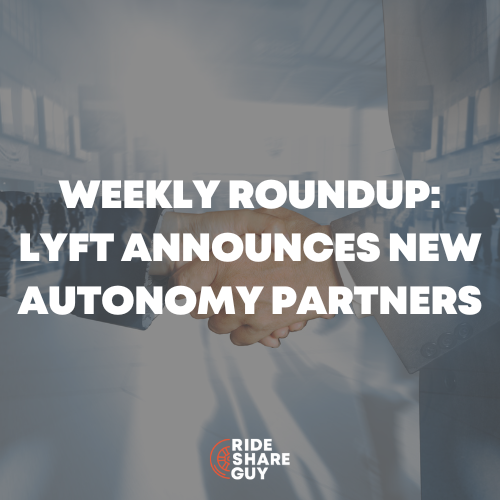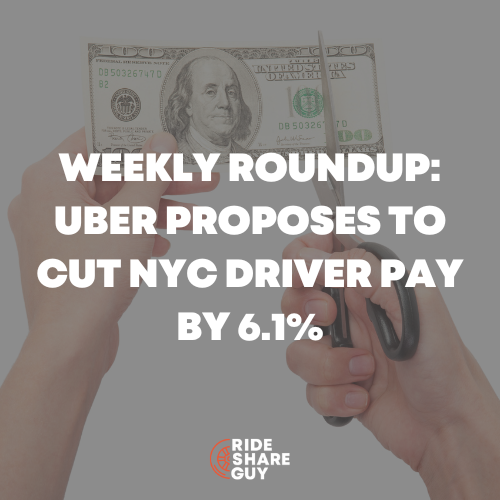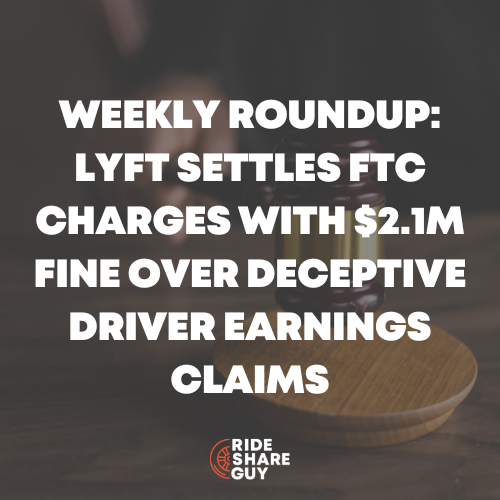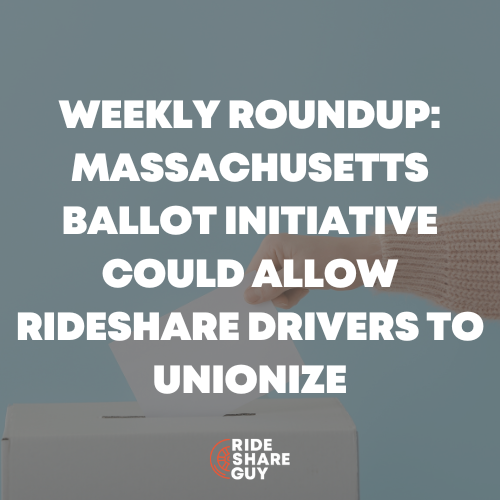I have always said that competition is a good thing for drivers and with Google’s entrance into the rideshare wars, things could get interesting very fast. I’d also like to welcome a new contributor today, Zeke Daniels is a rideshare driver and writer based out of San Francisco and today he brings us all of the top rideshare news of the past week.
Two blockbuster stories for the Rideshare Roundup this week and a whole host of lesser news Mcnuggets. I’ll get to the blockbuster stories in a moment, but this just in with just a twist of delicious irony … from David Streitfeld of the New York Times, Ratings Now Cut Both Ways, So Don’t Sass Your Uber Driver. Streitfeld, offers examples and evidence that drivers may have more power than they realize when they rate passengers.
The piece includes an interesting quote from Uber CEO, Travis Kalanick, about his personal plunge in passenger ratings. “I was at a 5 for a long time, then I had a string of 4 stars,” Travis Kalanick, the company’s chief executive, recently told San Francisco magazine. “I don’t know what happened. I think what happened was I was a little stressed at work. I was not as courteous as I should have been.”
If Travis was getting low passenger ratings because he was stressed at work, then we can only imagine what may soon happen to his passenger ratings now that two Uber sized threats have appeared on the horizon. Witness – these two blockbuster stories.
Google Takes On Uber
The first threat and blockbuster story is loaded with potential drama and intrigue: Google’s move to compete directly with Uber, Lyft and Sidecar using its own ride sharing app in conjunction with the driverless cars being developed in it’s Google X lab. Google has long been one of Uber’s biggest investors, but Boomberg first broke the story: Google Is Developing Its Own Uber Competitor. The two companies are going to war over self-driving taxis.
According to Brad Stone of Bloomberg News,
Google Ventures, the search giant’s venture capital arm, invested $258 million in Uber in August 2013. It was Google Ventures’ largest investment deal ever, and the company put more money into Uber’s next funding round less than a year later. Back then, it was easy for observers to imagine Google teaming closely with Uber, or even one day acquiring it. David Drummond, Google’s chief legal officer and senior vice president of corporate development, joined the Uber board of directors in 2013 and has served on it ever since. Now there are signs that the companies are more likely to be ferocious competitors than allies. Google is preparing to offer its own ride-hailing service, most likely in conjunction with its long-in-development driverless car project.
Uber Bets on Driverless Cars
For it’s part, Uber isn’t standing pat. They’re rumored to be entering a partnership with Carnegie Mellon University to develop driverless cars. Either way the competitive ridesharing landscape just grew more interesting. Google holds an ace in the hole in any competition: they own the best two navigation software systems: Google Maps and Waze. Should Google and Uber eventually look to develop a partnership, Google would have much greater leverage. Additional stories can be found here:
Engadget Article on the Google threat
Why Google’s rumored ride-sharing service should terrify Uber and Lyft
The other blockbuster news story this week has gotten less play in the media, because it’s subject to all kinds of legal mumbo jumbo that obfuscates the core issue, but it’s implications are huge.
Are Rideshare Drivers Employees?
The Wall Street Journal Reports: Judges Skeptical of Uber-Lyft Claims in Labor Cases Federal Judges Indicate Skepticism Ride-Sharing Drivers Are Independent Contractors
Here’s the essence: preliminary Superior Court hearings were held in San Francisco last week that will likely determine the status of rideshare drivers as employees or independent contractors. This has big money implications for both drivers and rideshare companies. The independent contractor status is integral to the business model of TNCs and if the courts rule against them on this issue, it could seriously affect profitability and valuations of these companies. (See Below)
One hearing was brought on behalf of drivers seeking class action status against Lyft in California. The second seeks similar ends against Uber. In both cases, judges gave clear signals that California law and precedents suggest that a ruling in favor of drivers over the companies is coming. If the driver’s suits prevail, rideshares companies will likely have to cover gas, car maintenance, Medicare and car insurance payments for the drivers as well as contributing to social security. Let’s do a few back of the envelope calculations to see how much might be at stake for drivers and TNCs.
Uber has 160,000 drivers most of them part time like me. I’ve yet to seen any reliable figures on average miles in driver mode per year per driver, but let’s say I’m typical. Driving mostly on weekends for only half of the year I logged just over 6000 miles in driver’s app last year. Applying the IRS guidelines for reimbursement for business miles driven of 56 cents a mile, we’re talking about $3360 in mileage reimbursements. Throw in $1000 year for tires and maintenance another five hundred for insurance and suddenly Uber or Lyft is shelling out $5000 per driver per year on an ongoing basis.
In Uber’s case it would translate into an $800 million dollar hit direct to it’s bottom line. Price/Earnings Ratio is a widely used in stock evaluation but Since Uber is still a private company, we can only guess, by using comparables. Facebook’s P/E ratio is high at 68. Googles is low for a tech company at 25. Let’s play it really conservative and say Uber’s stock is selling at 20 to 1 multiple. $800 million times 20 is $16 billion. So, the implementation of new guidelines categorizing rideshare drivers employees would shave $16 billion off Uber’s $40 plus billion valuation, or almost half the value on the company … overnight.
This also threatens a key strategic element of the TNCs competitive posture vis a vis drivers. Since today, TNCs have no fixed cost in carrying drivers, they have every incentive to aggressively recruit as many drivers as they can. It puts more drivers on the road, at no ongoing cost to the TNCs, and makes it much more likely that passengers will have to wait less time for a ride, but usually means that driver have to wait longer to get ride requests.
It also gives TNCs all kinds of leverage especially when it comes to threats of de-activation. Now, throw in this new ruling which will add fixed costs to TNCs of insurance and perhaps maintenance. Suddenly TNCs have to re-evaluate their policy on hiring and maintaining drivers. And none of this even addresses what will happen if drivers gain the rights to organize into unions, which would be mandated if the courts rule that drivers are employees. Under such a scenario, we can easily imagine a driver’s union amassing sufficient clout to have a say in what prices Uber and other TNCs charge passengers and the take that drivers get from that.
Suffice it to say these court cases are very significant, perhaps even existential threats to some TNCs, as investors internalize the longer term implications.
Now on to the Rideshare News McNuggets
Venture Beat has an interesting take on the Uberization of Silicon Valley, here: The article is a bit thin on facts, but presents a view of Uber and Silicon Valley that is worthy of discussion.
Lyft Marketing Goes Guerilla – Hoodline reports that the unconventional Lyft has taken to graffiti to market itself in San Francisco. According to the article,
Lyft, has hit the sidewalks of San Francisco with a hopscotch-style ad … The guerrilla marketing campaign was announced on Lyft’s Facebook page on January 30th. According to Lyft, more stencils can be found on the corners of Polk and Washington, Chestnut and Fillmore, 4th and Townsend (next to Caltrain), Post and Geary, and Market and Spear streets. The “skip your commute” campaign was launched in collaboration with “Instagram and Vine celebs,” such as this video choreographed by dancer Meghan Sanett. The hopscotch ads appear to have been spray-painted or chalked onto the sidewalk, though it’s unclear who is responsible for their removal once the campaign is over.
To conclude, here’s a warm and cuddly story from Australia which – dare we suspect – might have even been planted and promoted by Uber’s increasingly PR conscious team. The story is trending on Mashable’s list of stories about to go viral with 8.6 K shares an counting as of this writing on Thursday Feb 5 in the am. Uber announces kitten delivery service in Australia, cat lovers go wild. This should be enough to give you the flavor of the story … be the first in your office to have one.
Thursday is going to be a good day. On Thursday, you get to cuddle a kitten at your desk. In news sure to make people cry tears of joy, ride-sharing company Uber has teamed up with animal shelters across six Australian cities to bring a furry friend to your office for the ultimate 15 minutes of snuggle time. That’s right: a kitten in your office to cuddle. Clear your schedule. Now, when the boss asks you to do another mundane task, just smile and continue to pet a cat.
With this initiative, Uber is encouraging Australians to use their disposable income to care for a kitty or other animals, as there are millions of neglected animals in shelters across Australia that are waiting for a good home. It’s a smart move for the often controversial company, which was forced to apologize for price surging during the Sydney siege.
Readers, what do you think about all of the Google v. Uber news of the week? Is it a good thing for drivers or will we ultimately be worse off?
-Zeke @ RSG





